WESTERN NEPAL
We began our travels with a wildlife safari in Royal Chitwan National Park. We flew (flight was more than an hour late) from Kathmandu to Bharatpur in a twin otter DHC-6/300. The ‘pre-flight’ consisted of giving us cotton to plug our ears and a piece of hard candy. Although there were 20 seats, there were only six passengers other than us, and four of them appeared to be hill people on their first flight. Some were sick, and all were frightened. It was an interesting flight through low mountain passes over terrain that likely would have been beautiful in cleaner air. When we landed in Bharatpur, an old jeep picked us up. We drove through a few small villages, and we had to stop once to fix the jeep. It took us about two hours to get to the park.

Our ‘home away from home’ at tent camp
Royal Chitwan National Park is approximately 125 miles west-southwest of Kathmandu. The park is comprised of 360 square miles, and it is adjoined by another 200 square miles of the Parsa Wildlife Reserve. This land includes hills, rivers, flood plains, and tropical to sub-tropical forest. It has a unique ecosystem that is home to 43 species of mammals, 450 species of birds, and 45 species of amphibians and reptiles. It is also one of the last remaining homes of the Asian one-horned rhinoceros and the Bengal tiger.
The park land had been a big game hunting ground for royalty until the 1950s. Large numbers of people moved to the area in the 1950s, and they put pressure on the wildlife through their settlements and poaching. Wildlife numbers began falling precipitously, and the now-park was declared a rhinoceros sanctuary in 1964. This entailed relocating 22,000 human residents from the area. The park was formally established in 1973, and it became a World Heritage site in 1984 – and none too soon. A survey in the early 1970s reported that only 100 rhinoceros and 20 tigers remained. However, a survey in 2000 found 544 rhinoceros and 80 tigers. Hopefully these numbers will continue to increase.
We booked our time in the park with a company named Tiger Mountain because they actually have accommodations inside the park including a tent-camp and a lodge. We booked two nights at each.
After arriving at the park, it took another half hour to reach the tent camp. We traveled by jeep, boat, then another jeep. We saw many deer, wild pigs, and birds including a serpent eagle. Then we walked the remaining short distance to camp. When we arrived, we found it was well worth the effort.
The camp had one central building for meals and meeting others, and it had twelve semi-permanent tents set up in individual private areas. Each had a separate bathroom tent attached with running water and flush toilet. They did not, however, have any electricity – oil lamps only.
We were given a cool drink and a brief introduction and orientation by one of the naturalists. One of the staff showed us to our tent, and we were told that there would be an elephant waiting to take us on safari in one hour. We freshened up and settled in to our tent, and we headed back to the meeting lodge.
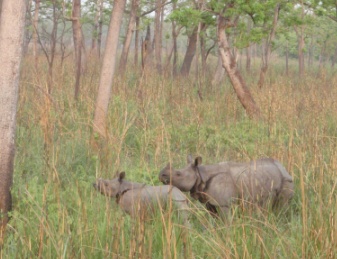
One-horned rhinoceros cow & calf
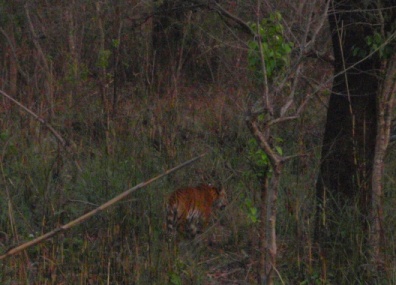
Bengal tiger – taken from atop an elephant’s back
This is when we met Shamsher – aka Tusker. Tusker is a large 29 year old male elephant, and we were surprised to see males being used for safari. But Tusker is quite a gentleman, and we were immediately smitten.
We sat on a platform on Tusker’s back with the mahout sitting on his neck. We rode over the grassy plain that we overlooked from our tent, through a river, and in to the sal forest. Over the next hour or so, we saw many one-horned rhinos – probably 20 or so. Most were grazing, a few were in the river, and a few of them were cows with calves. One got testy and got in Tusker’s face, but he did not flinch. We were impressed. Then we heard a whistle that seemed to be coming from a human. Our mahout, who spoke only a few words of English, said, “Tiger”, and we were off.
The mahout seemed to know where the whistle had come from, and we soon spotted another elephant in the tall grass. We quickly approached, and there was a male Bengal tiger. The tiger was not happy to see us, and he did not stay around long, but we were thrilled to have seen him.
Daylight was fading, so we headed back to camp. This had been a great beginning to the safari part of our travels with one exception. The mahout was hitting Tusker with a stick while we were on him, and we could not understand why. Tusker was behaving himself and following directions. Was he being hit just to move faster? We were troubled by that.
The mid-day heat was brutal, so we had the option to go on elephant safaris in the early morning and/or late afternoon. We had a watering hole about 150 yards in front of our tent, so we declined the early morning safari, and we spent part of the morning drinking coffee and watching the rhinos wallow in the watering hole. Bud hiked to a bird blind to see some of the many local species, and we both found it much too hot to nap. So we hung out and waited to go on another afternoon elephant safari.
Our next elephant safari was on a smaller female named ChanChunkali. This was a remarkably well trained elephant. We were impressed with the mahout’s ability to maneuver her in any direction with subtle signals. We had been out only about half an hour when we again heard the whistle indicating that another mahout had found a tiger. Our mahout started pushing ChanChunkali to go faster (we did not want her to go any faster because she is a very rough ride). He started hitting her repeatedly with a stick. We were shocked. Then he pulled out his ankus. This is a piece of corrugated metal rebar with a strait point as well as a curved hook. He started hitting her – beating her – with his ankus to get her to go faster. We could only hold on and cringe with each blow.
Four elephants congregated, but we did not see the tiger. Then the elephants picked up the scent, and they became a bit agitated and excited. They were trumpeting and tracking the tiger. Eventually the riders on two elephants saw a dark figure moving through the grass as the sun was setting, but we did not. We returned to camp shaken by our experience.
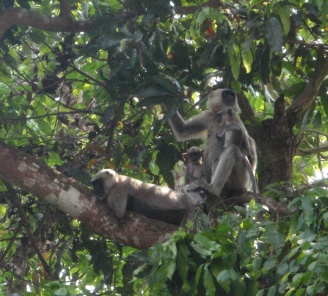
Rowdy noisy monkeys outside our room at lodge
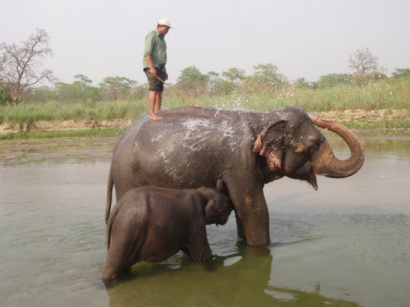
Mom & baby elephant cooling in river
We did not know what to do. Nita wanted to leave, but we had no transportation out. We decided that we would transfer to the lodge as planned the next morning, but we would not go on any more elephant safaris. We hoped that one less elephant would be abused if we did not go out. And so we did.
We moved to the lodge which is also inside the park. The lodge is getting old, and it is showing its age. But it is also still within the park, and the wildlife around it was plentiful (including a scorpion in our room). We had a troop of monkeys just outside our window, and the elephant camp was a short walk away.
We went to the elephant camp and talked to the ‘elephant manager’ about our experiences of the elephants being hit. He claimed that they sometimes needed to be hit to control them.
We explained what happened on ChanChungkali (she was behaving perfectly), and he implied that we were ignorant city slickers who should defer to their superior knowledge. He did not want to discuss this with us. We were disappointed, angry, and disgusted. We vowed to follow up on this after we returned home (and we have).
From the lodge we went on a few jeep safaris, and they were surprisingly productive. Animals do not seem to be particularly bothered by the jeep, and we saw a lot. We saw tiger tracks on one, and we enjoyed learning a bit about tracking (we did not find the tiger). We also went on a canoe safari down the Rapti River. The highlight of this outing was seeing numerous gharial crocodiles.
After two days at the lodge, it was time for us to leave the park, and we were glad to leave. Although it had been an amazing experience in some ways, we were both still very upset by the mistreatment of the elephants and our inability to do anything about it. We were ready to move on.
Again, it took us two jeeps and one boat to get us out of the park and to the nearest airstrip where another vehicle picked us up. Our next planned stop was at another lodge run by Tiger Mountain in Pokhara.
Our transport to Pokhara was a van without air-conditioning and a driver whom spoke only a few words of English. We did not anticipate either of these to be problems, but we also did not anticipate the delay in our travel.
We drove north from the park along a very poorly maintained road that roughly followed the Narayani River (a major tributary of the Ganges further south). It took us two and a half hours to reach Mugling where we turned west on the main road between Kathmandu and Pokhara – the Prithvi Highway. We were then 60 miles from Pokhara.
We traveled west on Prithvi Highway roughly following the Seti River. We made it only 25 miles – to the village of Damauli – and traffic came to a halt. West bound traffic was not moving, and there was no east bound traffic. Our driver got out to investigate.
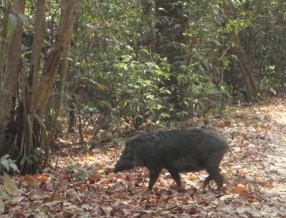
Wild pig
While our driver was gone, angry young men with large sticks (one with an axe) were walking back and forth by the stopped vehicles. We were getting uncomfortable with this situation, and we were looking around for possible escape options if this situation ignited. Our driver returned after about half an hour, and in his limited English, he said that a local villager and a bus driver had a fight. We were unclear how a fight turned in to a complete block of a major highway, but we lacked the language skills to pursue it.
We sat there in the sun for three and a half hours hoping this would resolve, and finally it did. We again got underway and traveled the remaining 35 miles to Pokhara without incident.
We subsequently learned a bit more about what had happened on the road. The night before, a local man did not get the discount he believed he deserved on his bus fare, and he beat up the bus driver. The bus driver went to the police, and the police took no action. So the bus drivers joined forces, and they blocked the road to get the attention of the local police. There had been busses blocking the highway both in front of and behind us until they were satisfied with the response by the police. This type of vigilante justice remains common throughout much of Nepal.
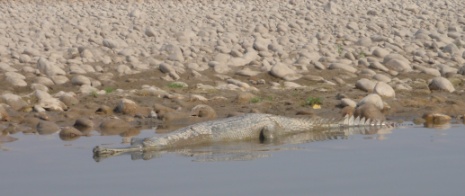
Gharial crocodile in Rapti River
Pokhara is Nepal’s number two tourist town – second only to Kathmandu. It is also a completely different experience from Kathmandu. Pokhara is a small laid-back town developed around three lakes. It is also known for its clean air – hah!
Tiger Mountain’s lodge in Pokhara is actually about half an hour’s drive out of town, and we never made it in to town. We spent our first day there doing laundry and catching up on a few chores. On our second day we went for a short hike around the village. So, we left without ever making it to town. We will take it on faith that the town is lovely just as we have to take it on faith that the view of the Himalayas from there is usually spectacular.
Follow us as we move on to Kathmandu Valley or jump ahead to eastern Nepal.